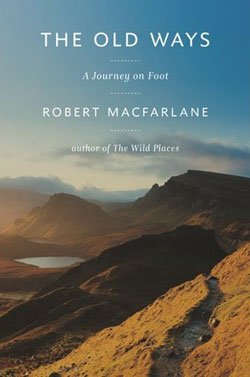“The Old Ways”
"The Old Ways", Book Reviews, Europe, History, Robert Macfarlane, Travel Writing
Rachel Cooke goes for a walk in the course of interviewing Robert Macfarlane, author of a new book (being released in October in the USA, but already in print in the UK) on Britain’s ancient tracks, holloways, drove roads, and sea paths.
Examine a large-scale map of the Essex coastline between the river Crouch and the river Thames, and you’ll see a footpath which departs the land at a place called Wakering Stairs and heads east, straight into – or so it appears – the North Sea. A few hundred yards on, it veers north, heading out across Maplin Sands until, three miles later, it turns back in the direction whence it came, finally making landfall at Fisherman’s Head, on the edge of Foulness Island.
Can this carefully traced line be for real? Certainly. You are not hallucinating. This is the Broomway, a path that is said to date from Roman times, and when Robert Macfarlane agrees to go walking with me, it’s his first idea. Am I excited about this? Yes, and no. I’m thrilled at the idea of heading out with Macfarlane; I feel like a marathon runner who’s been invited to train with Paula Radcliffe. But then I read his book, The Old Ways, and anxiety rolls in, like Essex mist. The Broomway, which can only be crossed when the tide is out, is the deadliest path in Britain; Edwardian newspapers, relishing its rapacious reputation – 66 of its dead lie in Foulness churchyard – rechristened it “the Doomway”. As he notes, even the Ordnance Survey map registers the “gothic” atmosphere of the path: “WARNING,” it reads. “Public rights of way across Maplin Sands can be dangerous. Seek local advice.” I admire Macfarlane hugely; I would love to watch him “walking on silver water” in the “mirror-world” that is the Broomway. On the other hand, I would probably prefer not to drown in the service of trying to tell you what a good writer he is.
——————————

Wikipedia: The Broomway provided the main access to Foulness for centuries. It is an ancient track, which starts at Wakering Stairs, and runs for 6 miles (9.7 km) along the Maplin Sands, some 440 yards (400 m) from the present shoreline. The seaward side of the track is defined by bunches of twigs and sticks, shaped like upside-down besom brooms or fire-brooms, which are buried in the sands. Six headways run from the track to the shore, giving access to local farms. The track was extremely dangerous in misty weather, as the incoming tide floods across the sands at high speed, and the water forms whirlpools because of flows from the River Crouch and River Roach. Under such conditions, the direction of the shore cannot be determined, and the parish registers record the burials of many people who were drowned.




